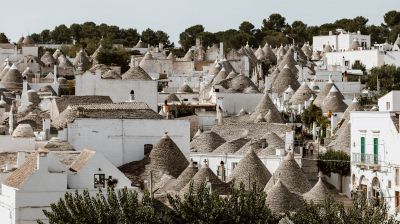Florence, Rome, Venice. Beautiful cities to be sure, not to mention some of the planet’s most visited travel destinations. Yet this popularity means that for many, Italy’s premier hotspots are too expensive and overcrowded to warrant a visit. If you want to enjoy a true taste of Italy without the tourists, check out the special Italian town of Alberobello.
Alberobello is a lovely town near Bari in the region of Puglia. It is home to the Trulli – cone-shaped white buildings that look like houses straight out of a fairytale. The village is a labyrinth of narrow streets and charming piazzas, while it also has a beautiful belvedere that offers fabulous views of the town.
These curious conical-roofed whitewashed structures, clustered in pockets of Puglia like wild fungi, are an icon of the region. In fact, this peaceful part of southern Italy is the only place they have ever existed.
Alberobello, a town of just over 10,000 people, is home to Puglia's finest and largest concentration of trulli. As one of the ‘must do’ items on everyone’s itinerary, the town has inevitably become a little overcrowded with day trippers and tour groups, but it can still be enjoyed if you visit early and with your expectations managed.
In the words of Unesco, which declared Alberobello a World Heritage site in 1996, the easily recognizable trulli (the singular form is trullo) are “remarkable examples of drywall (mortarless) construction, a prehistoric building technique still in use in this region. The trulli are made of roughly worked limestone boulders collected from neighboring fields. Characteristically, they feature pyramidal, domed or conical roofs built up of corbelled limestone slabs.”
How did these unique buildings come to be in Puglia? As with many pivotal moments in history, it is all to do with tax and money.
In the 1500’s, the Acquaviva family, the local rulers within the feudal system, wanted to avoid paying property taxes to the King. They ordered local peasants to build their houses and dwellings without mortar so that, in the event of a royal inspection, the structures could quickly and easily be taken down, and the tax bill would remain low. Using local limestone and some ingenious building techniques, the local population created the trulli, many of which remain standing today.
Puglian peasants, who had to tear the rulers’ houses down whenever an inspection was on the horizon, were less happy with the situation. In the 1700s and, after several petitions from discontented citizens about the ongoing treatment and rule by the Acquaviva family, the King granted their wish to become a ‘royal’ town, and therefore free from the whims (and tax-dodging preferences) of their feudal lords.
After this decree, unsurprisingly, there was less reason for trulli to be built. However, they stand today as a testament to the lengths the powerful will go to keep their wealth, and the perseverance and resourcefulness of the powerless to make the best of their situation.
Today, the majority of Alberobello’s residents do not reside in trulli. Instead, the town's 1,500+ wonderfully preserved and restored trulli have evolved into souvenir shops, restaurants and, of course, accommodation for visitors looking for a unique experience. You can also take a two-hour walking tour in town to discover more about the history and importance of the trulli.
During your next visit to Puglia, step off the beaten path and discovery the fairytale-like town of Alberobello.



